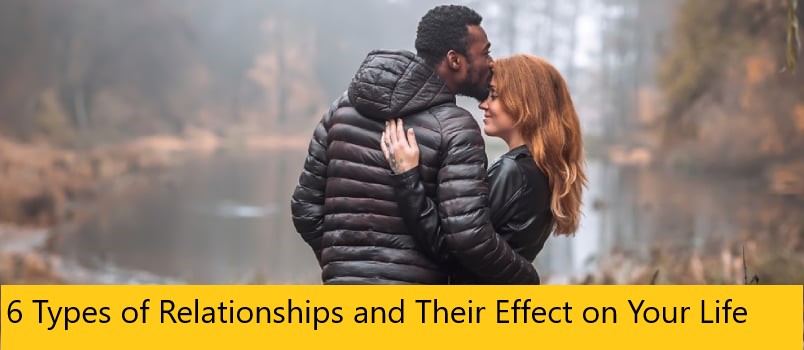Types of Relationships and How They Affect Your Life – There are many different types of relationships you will run into over your dating years. Some of them are fantastic bonds that will shape and change your romantic future, but others are painfully irritating reminders that the game of love has many faces.
So if you are wondering what kind of relationships are there, the article shares an account of 10 types of relationships that you might encounter in your life.
Moreover, we also reflect on what compatibility is in a relationship, what is a perfect relationship, and some relationship skills you can learn to form a healthier relationship.
What is a relationship?
A relationship is a state of being connected to the other person where both partners have some accountability towards each other. Trust is the most integral part of any relationship a person has. To better understand what it means to be in a relationship, give this article a read. These insights will help you understand the true meaning of a relationship.
25 types of relationships
Here are the 25 different types of relationships between people you will cross paths with, whether you like it or not.
1. The first
Your first relationship is a special one, even if it didn’t feel like it at the time. In the first serious romantic relationship, you have set up the path for how you are in relationships to follow.
It teaches you what you’re good at, what areas need improvement, how you communicate, kiss, how you trust, and how faithful you intend to be. Your first relationship is the beginning of everything.
2. The rebound
Different types of relationships all have their own unique set of circumstances, but none quite as complicated as the rebound. The rebound occurs when you are freshly out of a serious relationship and are still nursing bruises.
Your self-esteem is shot, and so you pursue a relationship with someone new way too fast. You’re essentially filling time with someone to do date-like things with until the real deal comes along. This is unfair to your partner and to yourself.
3. Controlling relationship
A controlling relationship is not a fun one to be a part of. Often going hand in hand with jealousy, a controlling partner wants to monitor your social media and electronic devices.
A study concluded that the characteristics of a controlling individual include a strong need for social interest from others, an expectation that others will include him in their social groups and activities, low internal proneness to conflicts, and internality in the area of interpersonal relationships.
In such types of relationships, your partner may even demand proof of where you are at any given moment. They may try to control who your friends are and how much time you spend with other people. This is an unhealthy, damaging relationship.
4. Clingy relationships
Being a clingy partner often stems from insecurities. You may not feel good enough for your mate or have dealt with broken trust in a former relationship that has carried on to your current one.
This can lead to a barrage of text messages to your partner that you think seem sweet but are actually overbearing and a little annoying. Spending time together is key to maintaining a strong bond as both friends and lovers, but spending time apart is equally as important.
Read More : Salvabrani.com

You need to maintain your sense of self by pursuing your own friendships and hobbies outside your relationship.
5. Too independent
Opposite of the above types of relationships, there is such a thing as being with someone who is too independent.
If you are in a serious relationship and your partner is too independent to regularly spend time with you or to consider your opinion on important matters, this can be problematic.
6. The open relationship
Also known as a non-exclusive type of relationship, an open relationship is an intimate relationship that is sexually non-exclusive.
An open relationship implies having more than one sexual partner. In such a relationship, the partner agrees to engage in different types of romantic relationships or sexual activities outside their relationship.
7. Experimental relationship
Such types of relationships start out when you are trying to break the cycle and try something new. It can also be considered a dating relationship where you are exploring options you have never considered.
An experimental relationship allows you to see yourself from a different perspective and even influence what you look for in your future relationships.
8. Toxic relationship
When you’re in a relationship, you should feel special, secure, and happy. These types of relationships are just the opposite. A toxic relationship seems great at first, and your partner’s true colors begin to show.
Signs of a toxic relationship include:
- Passive-aggressive behavior.
- Physical or verbal abuse.
- Excessive criticism.
- The feeling of walking on eggshells around your mate.
- A severe lack of getting back what you’re giving to your partner.
What’s worse is that a toxic relationship drags down your self-worth, which makes it harder for you to leave. Moreover, a study even found that people with low self-esteem are the most subjected to such relationships.
9. Held by grief relationship
Such types of relationships are based on the concept that ‘misery loves company. In this relationship, the partners come together because they have a shared sense of loss or grief.
Their pain has brought them together as they needed someone to share their pain with. Such relationships usually fall apart as the pain begins to subside.
10. Opposites attract
Many couples find themselves in a relationship with someone with who they have fun, love, and want to spend their life, but they have little to nothing in common.
No shared hobbies or no common beliefs. Instead, their common bond is each other. This relationship can be a blessing. The opposite characteristics of both parties tend to balance the other one out and better each other.


